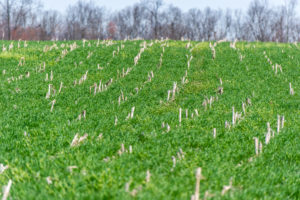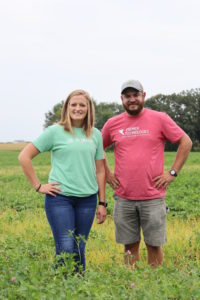Cover Crop Economics From the Field
Farmers enrolled in Practical Farmers of Iowa’s cover crop cost-share program are asked to fill out a survey at the end of each growing season. In 2024, 86% of more than 2,000 respondents reported that cover crops had a “positive or very positive” impact on their farms’ financial goals.
Farmers indicated that supporting factors such as reduced weed pressure, increased long-term yield stability and decreased costs of crop production influenced their financial goals for the better. We followed up with farmers to ask more questions about how cover crops influenced their farms’ financial goals.
In their responses, the four farmers shared that the value of covers ranged from improved soil health to offsetting rising fertilizer costs.
We asked where they have seen cost savings from using cover crops. A common survey response was reduced herbicide use. One benefit of cover crops – such as cereal rye – is the increased weed control provided by early spring competition and the layer of biomass after termination. This benefit, for the farmers that responded, directly correlated with their ability to reduce herbicide costs.
Our four respondents also shared other examples of how cover crops have saved them money or will save them money in the future.
Tama County, Iowa, farmer Al Schafbuch shared that cover crops make fertilizer more effective, so he has reduced the amount of fertilizer needed to achieve profitable yields. Al also said that the moisture savings from cover crops and practicing no-till have helped his crops to stay green longer in the fall, improving grain quality and yield.
Ticia Sanderson, who farms in Linn County, Missouri, says her hay costs are down because of cover crops. She is planning to graze the cover crops further into winter this year instead of haying the same grazing ground to see if there are cost savings there.
PFI board member and farmer Alec Amundson of Mitchell County, Iowa, sees potential to increase profitability by grazing cattle on cover crops and plans to expand that operation. Renting the land to graziers offsets some of the cost of land. “We’ve also sold clover cover crop as a feed source to neighbors with a feedlot, getting a second cash crop in a year,” Alec says.
Boone County, Iowa, farmer Keaton Krueger says cover crops are a generational strategy, and improving the soil in the long term should improve profitability. “It’s hard to assess a financial return on what the cover crops are protecting against, such as soil erosion, because those savings aren’t priced into the commodity crop equation,” Keaton says. He has not yet seen any savings or increased profit from planting cover crops.
The consensus is that it takes three years or more to see cost savings on inputs. Keaton hasn’t seen those savings yet but believes the extra cost from using cover crops will pay off in the long term. Ticia says this is her third year of using cover crops, and she is now seeing the first notable difference in fertilizer costs.
We also asked what data they record and use to evaluate the cost benefits of cover crops. Alec noted that he doesn’t record enough data but would like to. Many of his calculations are based on observations and paying attention to what other farmers are doing. Ticia records her seed cost, fertilizer cost, and the number of bales needed to sustain livestock through the winter months.
Cover crops do increase a farmer’s costs initially but have the potential to pay off in the long term. It is hard to put a dollar amount on some of the short- and long-term benefits, as Keaton pointed out. Preventing erosion – a common response in the cost-share wrap up survey – is one benefit that is difficult to quantify.
Even without factoring in soil erosion and long-term soil health improvements, farmers are seeing both cost savings and added profits from making fewer passes, using fewer inputs, increasing available forage and improving long-term yield stability.
Additional Resources:
- PFI Webinar: Coffee and Cover Crop Economics
- Farmprogress.com Article: Cover crops help reduce input costs
- Cover Crop Economic Decision Support Tool
- AGree Report: How Conservation Practices Influence Agricultural Economic Returns
- University of Missouri Center for Regenerative Agriculture Report: Cover Crops: A Cost-Effective Tool for Controlling Erosion
- University of Wisconsin Crops Extension Podcast: An Economist’s take on Dollars and Sense of Conservation Agriculture



